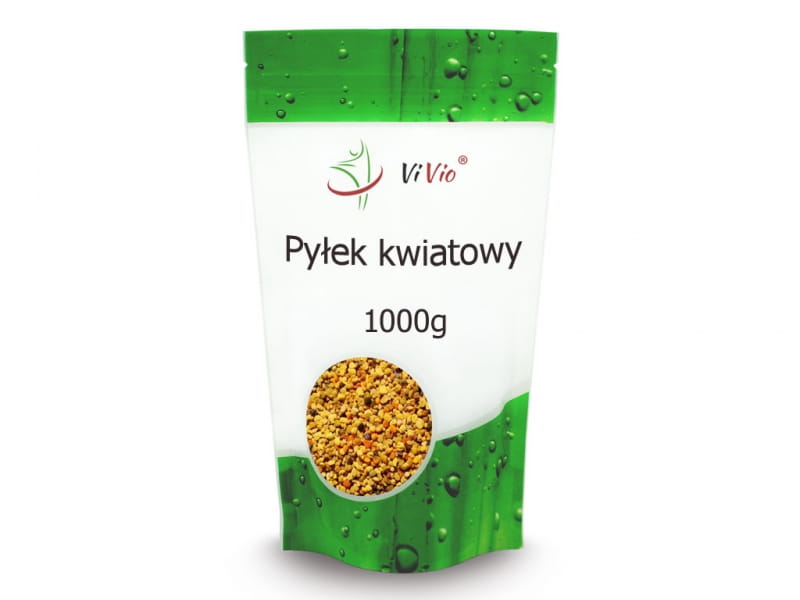Bee Pollen 1000g - VIVIO
- Regular price
- €31,26
- Regular price
-
- Sale price
- €31,26
- Unit price
- per
Couldn't load pickup availability
Description
xBee pollen is a real vitamin bomb. It contains B vitamins, vitamins C and E and provitamin A. The basic components of pollen are carbohydrates, proteins and lipids. The proportion of each ingredient varies depending on many factors, such as E.g.: soil type, climatic conditions, plant type from which the pollen was obtained. Pollen is also a source of valuable fatty acids (saturated and unsaturated) that help lower blood cholesterol levels. It also contains polyphenolic compounds, i.e. flavonoids and phenolic acids. Scientific research will also make it possible to detect the presence in pollen of peptide substances similar to growth hormones and gonadotropins (their function is to stimulate the sex glands to produce eggs and sperm). However, the content of these substances in bee pollen is small. Scientists emphasize that it can only have a positive effect on the cellular metabolism of the skin.
INGREDIENTS
bee pollen.
NUTRITIONAL VALUE OF THE PRODUCT IN 100 g
Calorific value - 1103 kJ / 261 kcal
fat - 5 g
- of which saturated fatty acids - 3 g
Carbohydrates - 31 g
- including sugar - 21 g
Protein - 23g
Salt - 0.1 g
NET WEIGHT: 1000 g
INSTRUCTIONS FOR USE
Pollen, which is available in granular form for health purposes, should be consumed 3 times a day half an hour before a meal. It is best to mix with water, milk and add to coffee or tea. It can also be eaten with honey or added to yogurt. It is good to chew the granules thoroughly, which increases the absorption of the valuable nutrients contained in the pollen. Many people wonder if it can be ground. A mortar or a coffee grinder will help us with this. The shape of the bottom does not worsen the quality of the product. In this form, pollen does not lose its properties and it is easier to use it for cosmetic purposes, for example, to make a home mask. If we do not like pollen granules, it can also be bought in tablet form in the form of various dietary supplements. However, they are enriched with additional ingredients, so it is better to consume pollen in its natural form without any artificial additives.
As a preventive measure, it is sufficient to take 1 heaping teaspoon of pollen per day. It can be added to tea, juice or water. Pollen can be ground before consumption. It is worth remembering that the action of pollen is more effective if we combine it with honey, for example, by sweetening tea.
Prophylactic dosage: up to 20 g per day, treatment dosage: up to 40 g per day, and in children up to 5 years old - no more than 10 g per day.
RECOMMENDED STORAGE CONDITIONS
Store cool and dry.
p >
similar products
- Regular price
- €31,26
- Regular price
-
- Sale price
- €31,26
- Unit price
- per
- Regular price
- €31,26
- Regular price
-
- Sale price
- €31,26
- Unit price
- per
- Regular price
- €31,26
- Regular price
-
- Sale price
- €31,26
- Unit price
- per
- Regular price
- €31,26
- Regular price
-
- Sale price
- €31,26
- Unit price
- per
- Regular price
- €31,26
- Regular price
-
- Sale price
- €31,26
- Unit price
- per
- Regular price
- €31,26
- Regular price
-
- Sale price
- €31,26
- Unit price
- per
- Regular price
- €31,26
- Regular price
-
- Sale price
- €31,26
- Unit price
- per
- Regular price
- €31,26
- Regular price
-
- Sale price
- €31,26
- Unit price
- per
- Regular price
- €31,26
- Regular price
-
- Sale price
- €31,26
- Unit price
- per
- Regular price
- €31,26
- Regular price
-
- Sale price
- €31,26
- Unit price
- per
Recently Viewed Products
- Regular price
- €31,26
- Regular price
-
- Sale price
- €31,26
- Unit price
- per
- Regular price
- €31,26
- Regular price
-
- Sale price
- €31,26
- Unit price
- per
- Regular price
- €31,26
- Regular price
-
- Sale price
- €31,26
- Unit price
- per
- Regular price
- €31,26
- Regular price
-
- Sale price
- €31,26
- Unit price
- per
- Regular price
- €31,26
- Regular price
-
- Sale price
- €31,26
- Unit price
- per
- Regular price
- €31,26
- Regular price
-
- Sale price
- €31,26
- Unit price
- per
- Regular price
- €31,26
- Regular price
-
- Sale price
- €31,26
- Unit price
- per
- Regular price
- €31,26
- Regular price
-
- Sale price
- €31,26
- Unit price
- per
- Regular price
- €31,26
- Regular price
-
- Sale price
- €31,26
- Unit price
- per
- Regular price
- €31,26
- Regular price
-
- Sale price
- €31,26
- Unit price
- per
- Choosing a selection results in a full page refresh.











